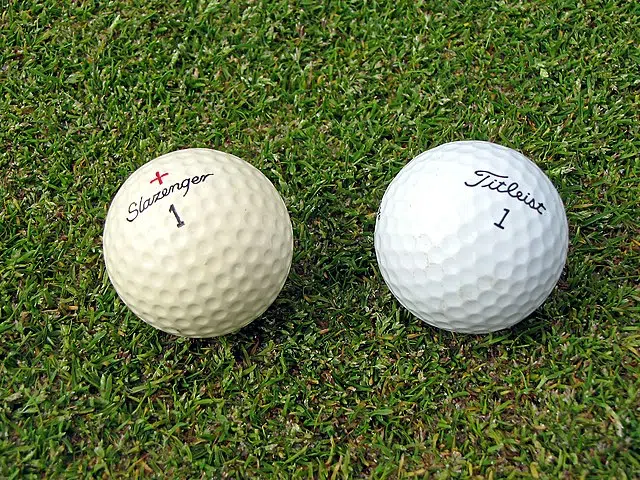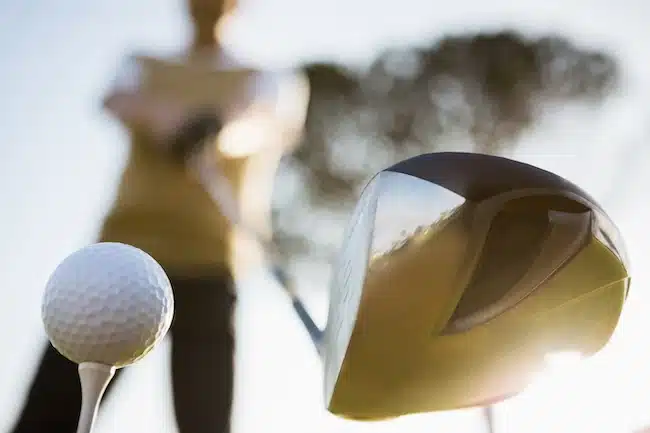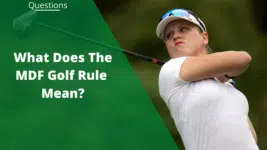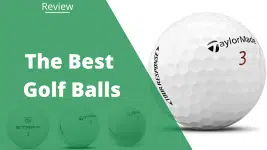As you learn the game of golf, you may find your golf ball expense are pretty high. Then after you’ve gotten better you may find you have so many golf balls around the house you aren’t sure which are good anymore.
Do golf balls go bad? A golf ball starts to lose quality after 5 or 6 rounds. An old golf ball could lose between 5 – 20 yards per shot. If there are any dings, dents, or scratches, you should replace the ball asap. Storing your balls at room temperature will help them last. New golf balls can last a decade or more on the shelf.
Understanding how long your golf balls last will help you save a lot of money over your golf career.
Read on to learn:
- Factors that affect golf ball durability
- Signs that your golf balls have gone bad
- Tips for prolonging the life of your golf balls
- Benefits of using fresh golf balls
- How to properly dispose of bad golf balls
Factors that Affect Golf Ball Durability
Four main factors affect the durability of a golf ball.
- Golf ball cover construction
- Golf ball inner materials
- Wear and tear
- Temperature and humidity
Golf Ball Cover Construction
The way your ball is constructed will impact how fast it goes bad. The basics of golf ball construction consist of a core (often rubber) and a cover. The cover of modern golf balls are made from one of two common materials.
The first golf ball cover type is called Surlyn. This type of ball is best for golfers looking for more distance and less spin.
Surlyn is the most durable of the two most common cover types.
Some examples of golf balls made with Surlyn covers include:
The second golf ball cover type is called Urethane. Most golf balls played by low handicappers and tour professionals fall into this cover category. This cover type allows for more spin, which is often an attribute better golfers look for.
Urethane golf balls are softer and more prone to damage than Surlyn golf balls.
Some examples of golf balls made with Urethane covers include:
Read more: The Best Golf Balls for the Average Golfer
Golf Ball Inner Materials
The next area to look at in the construction of golf balls lies in the inner workings of the ball. The ball’s core falls into three basic categories, two, three or four-piece construction.
The inner materials of the golf ball, along with the cover, help make them durable.
Golf swings and the skill sets of individual golfers are as unique as a fingerprint. If you choose a golf ball that is better for your swing, it will last longer for you because you’ll hit it more squarely.
Two-Piece Golf Balls
A two-piece ball is cheaper and could go bad sooner. But most brands are durable enough. They are basically the rubber core and the cover. They are best for middle to higher handicappers or golfers looking for more distance.
Examples of two-piece balls include:
Three Piece Golf Balls
A three-piece ball can be more durable than a two-piece ball yet is more cost-effective than a four-piece ball. They comprise the inner rubber core, a secondary rubber layer around the core, and the cover. These balls are better for middle to lower handicappers.
Examples of three-piece balls include:
A four-piece ball consists of the inner rubber core and either two additional layers around the core or two covers. Manufacturers that go with the two cover designs believe this. Under the outer dimpled cover, that secondary cover provides some extra cushion.
Examples of four-piece balls include:
- Titleist Pro V1x
- Srixon Z-Star XV
- TaylorMade TP5 (Actually a five-piece ball, with two covers and two layers around core)
Wear and Tear on Golf Balls
During a round, the following situations can contribute to taking the life out of your golf ball:
- Striking a tree or other similar obstacle
- Striking the cart path
- Frequent shots from the sand
- Total number of strikes to the ball
Even without damage from any of the examples above, a golf ball can generally only last up to five or six rounds. After that, it will start to lose its beneficial characteristics.
Golf balls constructed for higher handicappers or those looking for more distance are usually more durable. That is by design, as this golfer type has many more off-center hits.
They are also more prone to hit a tree or cart path more often, which will decrease the life of a ball. Golf balls with a Surlyn cover and two-piece construction are a good choice for these types of golfers.
Golf balls made for better players or tour professionals are not quite as durable. However, these golf balls are not usually put through the wringer as frequently since they are played by better players. Balls with a Urethane cover and made in a three, four or five-piece inner construction are best for these golfers.
Temperature and Humidity
Even the weather, and more specifically, temperature, can have an effect on the life of a golf ball. According to the USGA, distance decreases by two yards for every 10-degree drop in the temperature. But that fact alone won’t necessarily decrease the life of your golf balls.
Temperature comes into play as a factor in golf ball longevity in the temperature you store them at.
Storing golf balls in temperatures of less than 32 degrees Fahrenheit can lead to a considerable loss of distance. Studies have shown as much as 21 yards of carry distance can be lost with golf balls stored in cold temperatures vs. room temperature.
Humidity is also a factor that could determine the longevity of your golf balls. Make sure they are kept in a relatively dry place.
Read more: The Pros and Cons of Low Compression Golf Balls
How Much Distance Do You Lose With Old Golf Balls?
Generally speaking, as golf balls get older, their performance can deteriorate due to the construction, wear and tear, and exposure to temperature and humidity.
As your golf ball ages, it can reduce the ball’s spin, speed, and distance.
According to some estimates, using an old golf ball could cost you anywhere from 5 to 20 yards per shot compared to a newer ball.
However, this can also depend on your level of play and the specific characteristics of the ball in question.
What Is The Shelf Life Of Golf Balls?
New, unused golf balls do indeed have a shelf life. If stored properly, and namely, in terms of the temperature at which they are kept, golf balls can last up to ten years. After about a decade, they still can be used, but will start to show signs of deterioration.
Storing golf balls in a freezer has long been claimed to be a way of extending their shelf life. However, this has largely been seen to be a myth. Storing them at room temperature is ideal.
Do Golf Balls Go Bad In Water?
Diving into golf course ponds for golf balls has become a very lucrative business. These divers resell these golf balls to courses or golf shops to either use for their range or even sell back to golfers.
It is important to note that golf balls that have been exposed to water for long periods will ultimately lose the beneficial characteristics they were originally made to have.
Golf balls that have been sitting in a pond for a long period of time then recovered, cleaned, and resold, can be used in play. Just know you will not get out of them what you would from a new ball.
Read more: Do Golf Balls Float?
Signs that Your Golf Balls Have Gone Bad

There are definitely signs you need to make note of in determining the health of your golf balls. Some are obvious, and others may not be as noticeable. In either case, it is important to recognize when it’s time to put a new ball into play.
The most obvious signs of a dying golf ball are visual. These include the following:
- Cuts or scrapes in the outer cover
- A wearing down of the dimples
- A wearing down of the paint on the cover
- Noticeable lopsidedness
Some non-visual signs of a dying golf ball include:
- A gradual loss of distance on well-struck shots
- A noticeable loss of spin on approach shots
- A loss of spin on well-struck short-game shots
- Well-struck putts that don’t hold their line or speed
Any of these visual or performance signs and symptoms may mean it’s time to take a ball out of the rotation.
Read more: The Best Places To Buy Used Golf Balls
Tips for Prolonging the Life of Your Golf Balls
Like anything, how you care for your golf balls will extend their life. The following are my tips for getting the most out of the golf balls you play and extending their longevity.
- Play a ball that is right for your game- Make sure you play a golf ball that matches your swing speed, and your tendencies is important. Not just in how you can play but also in how long the balls last you. A higher handicap golfer should play a ball with a more durable cover. If they play a ball that is typically made for a better player looking for more spin, they will often see these balls get damaged quicker. This is because of more off-center hits, and brushes with cart paths and trees.
- Clean your golf balls– Cleaning them every few holes, and definitely after your round, can extend their life.
- Have practice balls and on-course balls- I have long been a major advocate of practicing your short game and putting with the same ball you would play on the course. With that said, I would suggest having balls you practice with and balls you play on the course. Same brand and model, but some for practice and some for play.
- How you store your golf balls- As mentioned previously, temperature and air moisture can have an effect on a golf ball’s performance. My suggestion, store a percentage of your golf balls that you currently have in play in a warm and dry place.
Read more: Do Golf Balls Have Dimples?
Benefits of Using Fresh Golf Balls
Did you know that tour professionals change out their ball every couple holes?
Even if there is no visible damage.
Under the rules of golf you can even change a ball during a hole. If all players in the group agree that the ball is unfit for play, you can replace it during a hole.
You will always get the maximum benefits of a golf ball when it is at its freshest. Even the slightest cut, or scrape can have an influence on performance.
Nowhere else during a round is this truer than on the putting green. You absolutely want a ball with the cleanest outer cover you can have while putting. It won’t take much to take a beautiful struck putt off line just enough to miss the hole.
How to Properly Dispose of Bad Golf Balls
Unfortunately, golf balls are not biodegradable.
Research shows that a golf ball could take up to 1,000 years to completely break down. With an estimated 300 million balls lost or discarded in the United States every year, this creates an environmental situation for sure. That number is not taking into account balls that are no longer usable for play too.
I would say the best thing to do with unwanted golf balls is to simply donate them. Even though the life of a golf ball is relatively short, there are always youth golf, or beginner programs that could use them. At that introductory stage, the health of the golf ball is not quite as important.
Some companies repurpose golf balls. One example is LostGolfBalls.com. They have a buyback program where you can sell your used golf balls. You can learn more about this at LostGolfBalls.com.
Final Thoughts
Do golf balls go bad? The long and short of it, golf balls do indeed go bad. Golf balls lose quality over time and usage, but proper storage and usage can help prolong their lifespan. Signs that a golf ball has gone bad include dents, cracks, or a loss of distance. Using fresh golf balls can provide benefits such as greater distance and control.
FAQ
How Long Will Unused Golf Balls Last?
If your golf balls are stored correctly, you can get up to 10 years out of unused golf balls. You can have an extended shelf life by keeping golf balls in a dry, temperature-controlled space.
How Many Hits Can A Golf Ball Take?
According to a 2009 Golf Digest article, the golf ball’s core can take 100 strikes at a 125 mph swing speed. So, that is roughly 7 rounds for the fastest swingers on the PGA Tour. That is the core of the golf ball. Obviously, the cover will go quicker and will lead to deterioration quicker.
Generally, you can count on a single golf ball to last about 5-6 rounds. That is without it striking a tree, cart path, or finding its way into the bunker frequently.
Do Golf Balls Go Bad In Heat?
Golf balls actually perform better, during play, in hotter temperatures. Hot air is less dense, so the ball has less resistance. This is just one reason why golf balls perform better in hot temperatures.
In terms of storage, however, extreme heat can start to degrade a golf ball. As we know, the temperature inside a car on a hot summer day can skyrocket. A 90-degree day can cause the temperature in a car to get as high as 140 degrees within an hour. This will absolutely have an effect on a dozen balls in your back seat.
Are 20-Year-Old Golf Balls Still Good?
You can still use 20-year-old golf balls. However, even unused, properly stored golf balls will lose the beneficial characteristics that they were made with after about 10 years.
What happens when you use 20-year-old golf balls the following:
- Loss of distance on full swing shots
- Loss of spin on full short iron shots
- Loss of spin on chips and pitches
- Loss of consistent roll on putts
Brendon is Class A PGA Professional and founded Little Linksters, LLC, and its nonprofit arm, the Little Linksters Association for Junior Golf Development. He won 25+ prestigious industry honors, including the 2017 PGA National Youth Player Development Award. He graduated from the PGA of America Management Program and has a handicap index of 7.8.
He has played golf for over 40 years and currently plays twice a month at the Eagle Dunes Golf Club near Sorrento, Florida. He loves Srixon clubs and plays a ZX5 driver with Z 585 irons. He's written over 60 articles on GolfSpan and specializes in sharing tips to improve your golf game. You can connect with Brendon at LinkedIn, X, IG, FB, his website, or BrendonElliott@pga.com.
- Best score: 69
- Favorite driver: Srixon ZX5
- Favorite ball: Srixon Z Star
- Favorite food at the turn: Turkey and cheese on white








